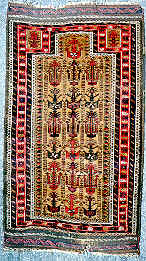Prayer Rugs
Prayer Rugs Guide
 Prayer Rugs are small, portable carpets used primarily by Muslims during their daily prayers to provide a clean and isolated space for worship, regardless of the surrounding environment. Typically rectangular in shape, these rugs often feature a niche at the top, which represents the mihrab of a mosque and is pointed towards the Kaaba in Mecca during prayer. The designs on prayer rugs are usually symmetrical and richly decorated with geometric, floral, or abstract motifs, and they often incorporate specific religious symbols or architecture. Made from various materials including wool, cotton, and silk, prayer rugs are valued not only for their practicality but also for their spiritual significance and the meticulous artistry they display. They are deeply embedded in the cultural and religious practices of Muslims around the world, serving both as functional items and as objects of beauty.
Prayer Rugs are small, portable carpets used primarily by Muslims during their daily prayers to provide a clean and isolated space for worship, regardless of the surrounding environment. Typically rectangular in shape, these rugs often feature a niche at the top, which represents the mihrab of a mosque and is pointed towards the Kaaba in Mecca during prayer. The designs on prayer rugs are usually symmetrical and richly decorated with geometric, floral, or abstract motifs, and they often incorporate specific religious symbols or architecture. Made from various materials including wool, cotton, and silk, prayer rugs are valued not only for their practicality but also for their spiritual significance and the meticulous artistry they display. They are deeply embedded in the cultural and religious practices of Muslims around the world, serving both as functional items and as objects of beauty.Disclaimer: The information provided in this article is for general informational purposes only. While we strive to ensure the accuracy and reliability of the information presented, we make no warranties, express or implied, about the completeness, accuracy, reliability, suitability, or availability with respect to the content. Any reliance you place on such information is strictly at your own risk. We recommend consulting with professionals for specific advice tailored to your project’s needs, particularly regarding building codes, regulations, and product specifications.
Under no circumstances shall we be liable for any loss or damage, including without limitation, indirect or consequential loss or damage, arising from the use of, or reliance on, the information provided in this article.
Prayer Rugs News
Latest Prayer Rugs News
Prayer Rugs...Muslims are often seen kneeling and prostrating on small embroidered rugs, called "prayer rugs." For those unfamiliar with the use of these rugs, they may look like small "oriental carpets," or simply nice pieces of embroidery. During Islamic prayers, worshippers bow, kneel, and prostrate on the ground in humility before God. The only requirement in Islam is that prayers be performed in... |
Turkish Rugs...urkish rugs also tend to be more coarsely woven than Persian rugs, and are always woven with the Ghiordes knot. The colors most frequently used are red and blue; green, their sacred color, is used on prayer rugs. You'll find Turkish rugs called Koula, Ladik, Bergoma, Milas, or Ghiordes. Wool is the primary material used to make Turkish rugs. Many rugs are made totally from wool where it is... |